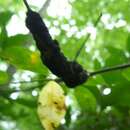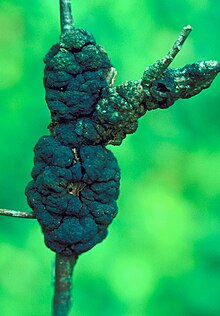pt-BR
nomes no trilho de navegação


Dibotryon morbosum or Apiosporina morbosa is a plant pathogen, which is the causal agent of black knot.[1][2] It affects members of the Prunus genus such as; cherry, plum, apricot, and chokecherry trees in North America. The disease produces rough, black growths that encircle and kill the infested parts, and provide habitat for insects.
The disease was first described in 1821 in Pennsylvania, but has spread across North America. While it was one of the most destructive diseases of plum and cherry trees in the late 19th century, today it is relatively well controlled in many cultivated areas and seen primarily in poorly managed orchards, or where strongly established, including in the wild. Many urban centres in North America have black knot control programs.
Black knot occurs only on the woody parts of trees, primarily on twigs and branches, but can spread to larger limbs and even the trunk. Olive-green swellings from the disease are visible in the late spring; as it spreads and matures, typically by autumn, rough black knots circle and kill affected parts. The knots vary in diameter from one inch to one foot (2.5–30 cm). Older knots can kill trees by promoting insect infestations.
The most common treatments are pruning infected parts during the winter and spraying buds with a fungicide. Nearby wild plants with the disease must also be treated.
Dibotryon morbosum is a fungus that affects the genus Prunus. Included in this genus are multiple species of trees and shrubs, such as: Dibotryon morbosum infects are Prunus serotina (wild cherry trees), Prunus persica (peach trees), Prunus domestica (plum trees), and Prunus cerasus (sour cherry trees).[3] The main symptom of Dibotryon morbosum is its “knot-like” gall structure. These knots can vary in size from anywhere to 13–305 mm (0.5–12 in) long, and up to 51 mm (2 in) wide. This fungus is typically diagnosed by these large black galls at the site of infection. The first signs of these symptoms are noticed during the winter because leaves are not obscuring the view. The first noticeable symptoms are small, light brown swellings. The next season, these swellings will turn dark green and have a velvety texture. The green swellings will darken and harden into the large black knots. These swellings often start as green in color during the beginning of the summer season and become black at the end of summer.[4]
Dibotryon morbosum has a relatively simple disease cycle. In the spring, after overwintering in a previous host, the fungus produces ascospores, which are stored in a fruiting structure known as the pseudothecia. These ascospores then get dispersed by the wind and rain until they find a susceptible host.[4] They typically infect their host on wounded tissue or shoots. The infection is not systemic but does grow and spread from the initial infection site. Symptoms are typically not noticeable in the season of initial infection, as the fungus grows inside the host. Throughout the summer, conidia are produced which also get dispersed by wind and rain. Conidia are asexual spores that help the fungus to spread within a given growing season. The conidia help the fungus germinate and produce other generations of the fungus, after, the conidia also helps the spores disperse by releasing them and allowing them to disperse through the wind.[4] The fungus then overwinters within the shoots and tissue of the host. It then produces ascospores in the spring to begin the cycle anew, but only after it has grown on its host for two winters. It will not produce ascospores the first season after initial infection but will continue to produce asexual conidia.
Dibotryon morbosum produces pseudothecia, fruiting structures that are embedded in the black stroma on the surface of the gall.[5] In the spring, two winters after initial infection, the fungus produces sexual spores called ascospores. The ascospores mature during the early spring of the infection's second season and are forcibly discharged into the air during rain events. The spores are distributed short distances on wind currents and through rain splashing. The anamorph, or asexual stage, produces abundant olive-green conidia during the summer on the surfaces of one-year-old knots.[5] The infection capabilities of the conidia are quite limited. Therefore, management strategies are focused on ascospore development and infection processes.
The fungus Dibotryon morbosum overwinters in the knots and once the ascospores are released. The spores are released during the wet periods of spring. The wind and rain carry these spores to infect young saplings or wounded branches.[5] The fungus favors warm and wet weather with any temperature within 60–80 degrees Fahrenheit as it is the most ideal for dissemination, germination, and infection of new plant tissue. Rainfall is also significant because it causes the spores to be released and begin infecting new plant tissue. The splashing of the rain helps transfer the ascospores along with air currents.
There are several ways that Dibotryon morbosum is managed. The first way to manage this pathogen is to choose strains that are genetically resistant. There are several resistant species of the genus Prunus that can be used, such as Prunus maackii, Prunus armeniaca, and Prunus triloba. Cultural management can also be used to help prevent Dibotryon morbosum. Removing the source of inoculum, ascospores, by pruning plants can be effective in managing this fungus. Pruning the branches should happen before spring as that is the time the buds break. It is also important to consider where Prunus species are planted. Areas that are known to have had issues with Dibotryon morbosum should be avoided because the black knot is a widespread fungal disease and will easily attack new growth and cause deterioration of plant and fruit growth.[6]
Chemical management can also be an effective way to manage Dibotryon morbosum. Fungicides can be used, but they are only recommended for use in severe cases and are often not very effective unless used with other cultural methods. Additionally, fungicides will only be effective if the source of inoculum is no longer present. Another way to manage this disease is by pruning the branches. Winter is the best time to look for galls since there are no leaves to obscure. By removing the galls the ascospores won't mature and spread to healthy tissues. Fungicides are able to be used but are only recommended for sites with valuable trees or very severe cases of the black knot. The fungicide will only work as a protectant if the cultural practices that were before mentioned are being done as well.[7]
Dibotryon morbosum or Apiosporina morbosa is a plant pathogen, which is the causal agent of black knot. It affects members of the Prunus genus such as; cherry, plum, apricot, and chokecherry trees in North America. The disease produces rough, black growths that encircle and kill the infested parts, and provide habitat for insects.
The disease was first described in 1821 in Pennsylvania, but has spread across North America. While it was one of the most destructive diseases of plum and cherry trees in the late 19th century, today it is relatively well controlled in many cultivated areas and seen primarily in poorly managed orchards, or where strongly established, including in the wild. Many urban centres in North America have black knot control programs.
Black knot occurs only on the woody parts of trees, primarily on twigs and branches, but can spread to larger limbs and even the trunk. Olive-green swellings from the disease are visible in the late spring; as it spreads and matures, typically by autumn, rough black knots circle and kill affected parts. The knots vary in diameter from one inch to one foot (2.5–30 cm). Older knots can kill trees by promoting insect infestations.
The most common treatments are pruning infected parts during the winter and spraying buds with a fungicide. Nearby wild plants with the disease must also be treated.
Dibotryon morbosum, también conocido como Apiosporina morbosa o Plowrightia morbosum, es un patógeno de la familia Venturiaceae que afecta árboles del género prunus.[1] Este patógeno es la principal causa del nudo negro, una enfermedad que solamente afecta a los árboles de este género, especialmente aquellos que viven en la región del noreste.[2] El género prunus se compone de la ciruela, la cereza, el melocotón y otros tipos de árboles similares.[3]
El nudo negro fue clasificado como una enfermedad desastrosa en 1811 en Massachusetts porque destruyó árboles de cerezas y ciruelas.[4] Esta enfermedad, sin embargo, fue descrita en el año 1821 por L.D. Schweinitz, un científico que hizo contribuciones importantes a la micología, como resultado de una expedición para capturar algunos ejemplares de hongos en Pennsylvania. Después, él y otros micólogos estudiaron el comportamiento del nudo negro y descubrieron que esta enfermedad ataca árboles susceptibles que están rodeados por árboles que no son susceptibles.[5] También descubrieron que reduce el número de árboles de frutas y obstaculiza su crecimiento.[6] Esta enfermedad provoca estrés al árbol, de modo que puede debilitarlo hasta el punto que se hace susceptible a otras enfermedades causada por otros patógenos o morir.[2]
El nudo negro aparece frecuentemente en las ramas de los árboles, pero también puede ocurrir en sus troncos.[7] Las ramas que son afectadas solamente pueden vivir por algunos años. Los árboles con muchas infecciones de nudo negro terminan deformados porque no tiene la energía para crecer normalmente.[4]
El nudo negro se puede notar en una rama cuando parece que está hinchada, como si tuviera un tumor, y el “tumor” es de color negro. Este “tumor” puede medir de 1 a 30 centímetros y tener una circunferencia de 1 a 2 pulgadas. Aunque este “tumor” puede llegar a ser muy grande, toma un par de estaciones para alcanzar su tamaño máximo.[4] Por ejemplo, pasa casi un año antes de que la rama tenga una estructura similar a la de un tumor. Esta enfermedad comienza a crecer en la primavera, y los primeros síntomas que se notan son pequeñas inflamaciones que son suaves y color marrón. En el verano, sin embargo, esta inflamaciones se ponen de color verde. Después de dos o más estaciones, las inflamaciones se endurecen y ponen negras cuando la enfermedad madura por completo. Por tener un proceso de infección muy largo, esta enfermedad se ha convertido en una gran amenaza para los árboles y es muy difícil para los productores de frutas y micólogos notarla.[8]
El Dibotryon morbosum, que vive en el nudo negro, se reproduce dos inviernos después de que se desarrolló en un árbol. El proceso de reproducción comienza cuando el patógeno produce ascosporas, esporas sexuales, por dos o tres semanas continuamente. Después, el patógeno hace uso de la lluvia y el viento para difundir sus esporas sexuales en árboles susceptibles y aumentar sus posibilidades de supervivencia.[8]
A pesar de que este agente patógeno y el nudo negro son muy peligrosos, están relativamente controlados hoy. Muchos productores de frutas han decidido cultivar árboles que tienen resistencia fuerte contra las ascosporas. También, algunos de ellos utilizan fungicidas para controlar el crecimiento del nudo negro y son más conscientes de dónde plantar sus árboles: en lugares donde no se ha reportado el nudo negro y no hay ningún árbol abandonado.[4]

Dibotryon morbosum, también conocido como Apiosporina morbosa o Plowrightia morbosum, es un patógeno de la familia Venturiaceae que afecta árboles del género prunus. Este patógeno es la principal causa del nudo negro, una enfermedad que solamente afecta a los árboles de este género, especialmente aquellos que viven en la región del noreste. El género prunus se compone de la ciruela, la cereza, el melocotón y otros tipos de árboles similares.
Apiosporina morbosa je grzib[7], co go nojprzōd ôpisoł Ludwig David von Schweinitz, a terŏźnõ nazwã doł mu Arx 1954. Apiosporina morbosa nŏleży do zorty Apiosporina i familije Venturiaceae.[8][9] Żŏdne podgatōnki niy sōm wymianowane we Catalogue of Life.[8]
Apiosporina morbosa je grzib, co go nojprzōd ôpisoł Ludwig David von Schweinitz, a terŏźnõ nazwã doł mu Arx 1954. Apiosporina morbosa nŏleży do zorty Apiosporina i familije Venturiaceae. Żŏdne podgatōnki niy sōm wymianowane we Catalogue of Life.